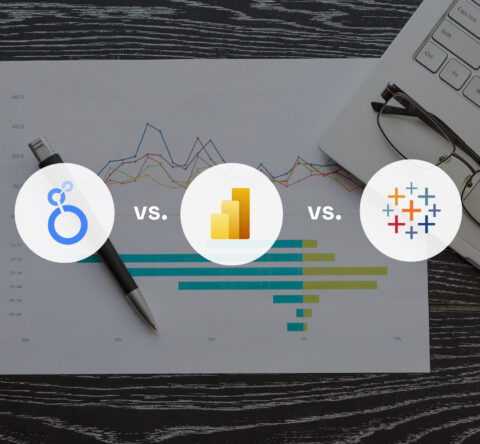With many business intelligence (BI) solutions in the market, choosing the best tool that suits your needs, preferences, and budget has become more challenging. BI tools also require different levels of expertise that should be factored in along with their various features and capabilities. But the most important factor is your business objectives.
BI tools serve different objectives, such as collecting, processing, analyzing, organizing, visualizing, and filtering large quantities of data. This allows for establishing a more efficient workflow across different departments and teams in your business and helps them deal with business data-related challenges and measure their KPIs.
Among various BI tools, many of them are truly outstanding. But here, we only focus on google data studio vs. Looker, and we will see how each platform stands in comparison. We will use different criteria to evaluate various operational aspects in comparing google data studio vs. Looker, including analytics capabilities, integration features, and modeling methods.
Ready? Let’s dive in:

Data Modeling
Data modeling is an integral part of any data processing and analysis. It is the foundation of data visualization and organization, allowing different teams in your business to collaborate more efficiently. Data Studio has handy data customization features that will help you derive data from the underlying data set and organize them based on various dimensions and metrics.
Looker has an entirely different modeling method called LookML (Looker Modeling Language). LookML is a language for describing dimensions, aggregates, calculations, and data relationships in a SQL database. With more than 100 premade modules and modeling patterns, LookML would be a convenient modeling solution.
Data models and blending is a telling aspect in Looker vs. data studio comparison. Data Studio offers a standalone model by accessing the data sources. Data Studio needs to operate in the underlying data platform. That’s why Data Studio is often not recommended for data blending unless it is accompanied by extensive validation.
Looker data modeling features, on the other hand, are more flexible. Looker allows you to combine different data sources, transform them and build a unified reporting model. It allows you to join datasets with all of the standard join types from SQL. Nevertheless, Looker data modeling output is eventually from your join, allowing a comprehensive validation.
Data Source Integration
When we compare google data studio vs. Looker, we must remember that both tools are Google products. Why does it matter? Because Google is a massive platform that allows many native integrations of data sources such as Google Analytics, Amazon Redshift, Google Ads, Google Sheets, BigQuery, Cloud SQL for MYSQL, and more.

Moreover, in data studio, you access 650 connectors and use integration features for pretty much any major data source. The data studio community connector is open-source, and you can create your own connectors if you can’t find the suitable one for your use case.
For many companies, data merging features are a necessary component of BI tools. Data merging is essential for social media management, CRM, search, finance, HR, advertising, etc. So, does data studio offer blending capabilities? YES. The data Blending feature is a left outer join in data studio that lets you create various tables, graphs, and charts based on multiple data sources.
Now, how does Looker appear from an integration perspective? With Looker, you need an SQL database for integrating from any source. What does it mean? Usually, when you run a huge business, you collect raw data from different sources in different formats. You will have to transfer all formats into a SQL database so that Looker would be able to read and process them.
Looker supports 50+ SQL dialects and has access to many common databases, data warehouses, and data virtualization systems, including Google BigQuery, Microsoft Azure PostgreSQL, Amazon Redshift, Microsoft SQL Server (MSSQL), Microsoft Azure SQL Database, and Snowflake.
Looker also offers merging features from different data sources. You can use the ‘Explores’ and ‘Merge Results’ features to create queries and organize them in a single unified table. Merged Results are post-query processing features that should be used carefully to prevent overtaxing Looker resources. You can also define functions and logic in LookML and generate and process SQL by your database.

Analytics Capabilities
Google has been long known for offering excellent analytic solutions, such as Universal Analytics and Google Analytics 4. Perhaps, one of the reasons that Google Data Studio doesn’t provide comprehensive analytic features like predictive capabilities is to avoid overlap. Businesses that rely on advanced predictions and forecasts for classifying and processing data may be better off using a different BI tool.
Moreover, Data studio does not support non-SQL languages such as Python. But you can use 3rd party tools or other readable connectors such as Google sheet to integrate non-SQL languages with Data Studio. Although, this may not be an efficient solution for huge databases.
When it comes to predictive capabilities like classification, regression, and time series forecasting models, Looker has a wide range of solutions and machine learning models. You can use the processed data to create charts and graphs and export them to various platforms to optimize your analytics.
This BI tool also offers embedded analytics features to better place your iFrame content. It also allows you to create an eye-appealing and user-friendly dashboard through Looker’s SSO embedding. This allows you to engage with your audience more efficiently and receive actionable feedback to help you identify weaknesses and shortfalls that require more attention.
Bottom Line
Data Studio and Looker are both Google products and share many characteristics and features. They are both powerful BI tools that can help organizations overcome business complexities by offering data visualization, integration, and analytics. Data Studio works best for simple needs and small businesses.
Looker has a wider range of integrative and analytical capacity that allows large enterprises to centralize their databases. If you’re running a marketing and advertisement campaign, Looker may be a better option because it allows you to import data to Google Analytics 360 for deeper analytics.
Overall, your business needs and goals determine what marketing solution works best for you. If you’re interested in learning world-class SEO and marketing tactics, don’t forget to check out other blogs on our website. And stay tuned for new content!
For more such blogs, Connect with GTECH, one of the best search engine optimization agency in Dubai.
Related Post
Publications, Insights & News from GTECH








